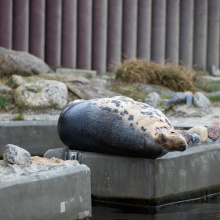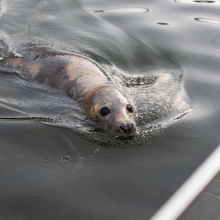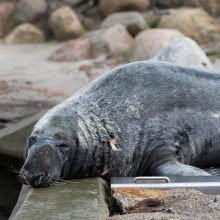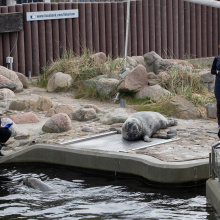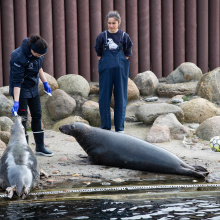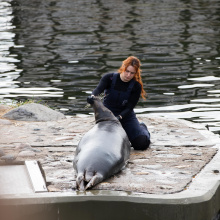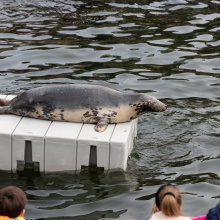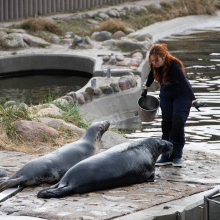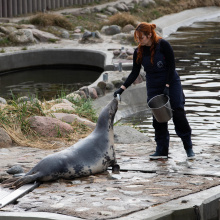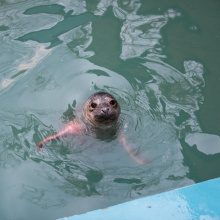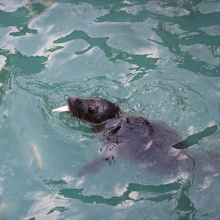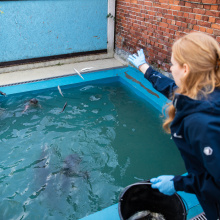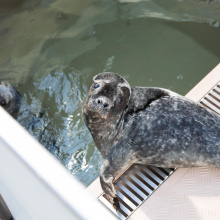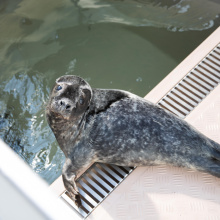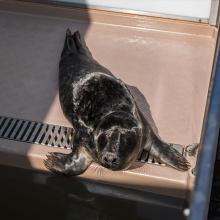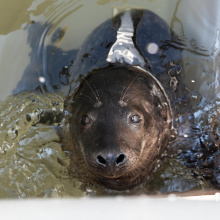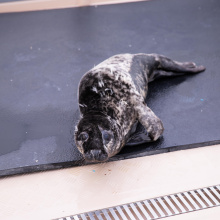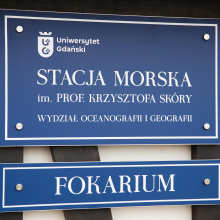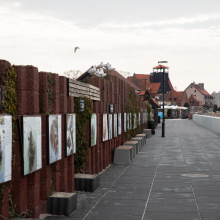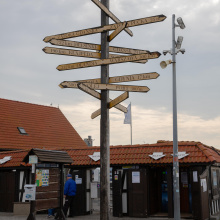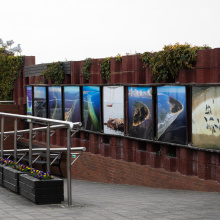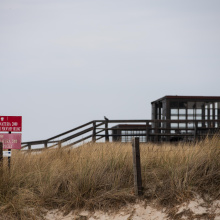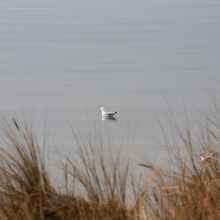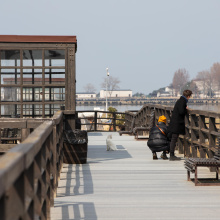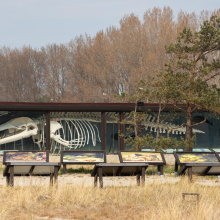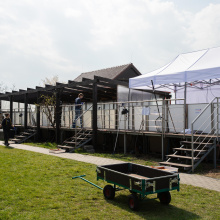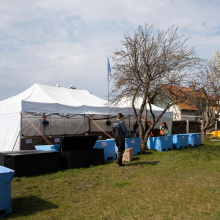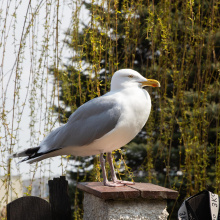The seal rehabilitation centre run by the Prof. Krzysztof Skóra Marine Station of the University of Gdańsk is in the middle of an intense season of helping this year's seal pups. The little seals arrive at the centre emaciated, dehydrated, often severely underweight and infected, and frequently injured. They require specialist care, regular feeding and medical assistance. This year, the Marine Station has already helped over 60 seals. The prognosis for the vast majority of them is good, and the first patients have completed their rehabilitation and returned to their natural environment. The Station's staff is assisted in caring for the animals by invaluable volunteers! It is worth remembering that visitors to the seal sanctuary do not have access to the pups - for the welfare of the animals, their contact with humans must be kept to a minimum. However, this is compensated by the opportunity to observe the resident seals up close and to watch the pups on cameras in the isolation rooms. We encourage you to watch a short film showing, among other things, the feeding and medical training of the seals.
Although the show presented during feeding may be associated with trained seal tricks, in reality it has nothing to do with them. It is medical training - it serves to check the animals' health in as stress-free a manner as possible and, if necessary, to carry out medical examinations and treatments. The seals are encouraged to cooperate through play and rewards, and the positions they are presented in are designed to enable specific diagnostic procedures to be carried out.
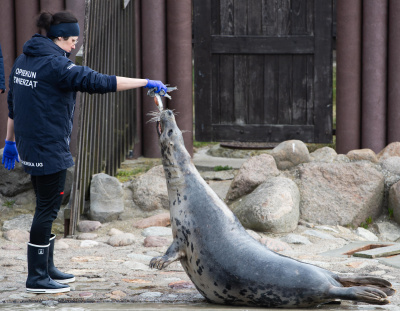
The resident seals are accustomed to the presence of humans and do not react to it with stress (although it is important to remember to follow the rules when visiting the Station - do not throw anything into the pools, hit the fence or take any other action that could harm the animals). The situation is different for pups - they are wild animals that associate the presence of humans with danger. Stress caused by contact with humans delays the recovery process; it would also be harmful to tame the pups, because they are ultimately to be returned to their natural environment. For this reason, carers try to minimise the time their charges are exposed to human presence by performing all necessary tasks (feeding, administering medication, cleaning) simultaneously and as quickly as possible (we wrote more about this here).
‘This year, we have already taken in 60 patients,’ says Dominika Jonakowska, a veterinarian employed at the Marine Station. ‘Apart from Orlica, all the seals were pups born this year. When we take a seal in for rehabilitation, we are always cautious in our prognosis: the animals are often in serious condition, extremely malnourished, with various injuries; we do not know how they will react to medication or whether they will eat. Fortunately, at the moment, most seals are in good condition. The pups are already eating fish on their own, are active, and their wounds are healing well - we will soon be preparing them for release into the wild. Unfortunately, three seals could not be saved.'

One of the important factors determining the possibility of young seals returning to their natural environment is their body weight - they usually arrive at the rehabilitation centre very emaciated, often weighing less than the typical birth weight. The pups are fed four times a day, initially with a fish soup prepared especially for them, and then with raw fish.
‘The starting portion is about 300 g per feeding,’ says Agata Godziszewska, one of the seal carers. ‘We start with fish soup, and then, when we see that the seal is ready for fish, i.e. it is bigger, larger and shows interest in what is in its pool, we switch to fish. If the seal understands that fish is food and starts to eat on its own, we gradually (by 100 g) increase the weight of the meals; eventually, we reach up to 1.5-2 kg of fish per feeding. A seal that eats this much is usually ready to go out into the open water. Caring for the little ones can be a huge challenge - volunteers who help prepare meals and clean the areas where the animals stay are invaluable to us. We are very grateful to them!’
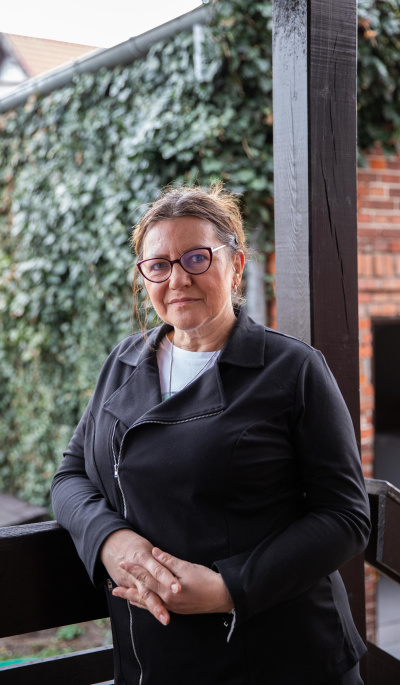
Dr Iwona Pawliczka vel. Pawlik
It is worth noting that the pups that come under the care of the Station are not born in Poland: they arrive from the coast of Estonia and other areas of the Baltic Sea. Grey seals are born here mainly on ice, less often on land. Probably the sandy shoals where grey seals live in the Vistula estuary are too unstable for them to decide to breed. So far, only one case of a wild seal birth in Poland has been confirmed:
‘To confirm that a pup was born in Poland, we need to observe it together with its mother,’ says the head of the Prof. Krzysztof Skóra Marine Station, dr. Iwona Pawliczka vel Pawlik. ‘So far, we have only recorded one such observation. How do the pups end up with us? Seals usually give birth on the ice, close to the edge, so that the mother has easy access to the water and can get back to her pup. Sometimes the pup slips into the water, and then the mother has no chance of finding it. Sometimes the block of ice with the pup breaks off and starts to drift, which also causes premature separation of the young from the mother. Unfortunately, it also happens that the mother dies before the young are able to live on their own. Such lonely young move around blindly and sometimes end up on our coast, and if they are lucky, they reach our centre. Seals take care of their offspring for only a short time - about three weeks - but during this time the pup must significantly increase its body weight, develop waterproof fur (grey seals are born covered in white, water-permeable lanugo) and learn to hunt for food on its own. If separation from the mother occurs at an earlier stage, the pup has no chance of survival without human help.’
For the latest information on seal patients, please visit the Facebook and Instagram pages of the Prof. Krzysztof Skóra Marine Station in Hel. There you can see videos of the happiest moments at the seal rehabilitation centre, i.e. the return of seals to the wild, as well as unique shots from the seal nursery and isolation rooms.
You can also support the seals financially: ratujemyzwierzaki.pl/organizacje/fokarium/.
We would like to remind you of the basic rules to follow if you encounter a seal on the beach:
- keep a safe distance from the seal - at least 30 metres (the further, the better);
- inform the Marine Station in Hel (tel. 601 88 99 40) or the WWF Blue Patrol (tel. 795 536 009) about your observation; it is a good idea to include a photo of the seal from a distance with your report;
- keep dogs on a leash and do not allow them to approach the seal - if disturbed, the seal may defend itself or flee into the water, which may worsen its condition; remember that there are many pathogens that both we and our pets can contract from wild animals; pets can also be a source of disease for weakened wild animals;
- remember that seals are aquatic animals, and their presence on the beach is not a cause for concern - seals come ashore to rest, mate and moult, and after regaining their strength, they return to the water on their own; therefore, do not pour water on seals, push it back into the water or attempt to help it in any way. Please leave it to the specialists from the Marine Station and BP WWF to assess its condition and provide assistance;
- you should also inform passers-by of the seal's presence and the need to keep their distance, as well as the other rules mentioned above.

